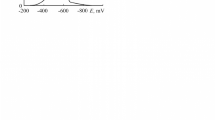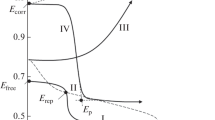Abstract
We establish that ozone in a 10–15% hydrochloric acid solution at 20°C has no effect on the corrosion-electrochemical behavior of titanium and its alloys with aluminum but promotes passivation at 40°C. The addition of ozone to 15% HCl at 40°C and to a 20% solution at 20°C leads to the transition of alloys to the state of unstable passivity. Titanium can be used as a structural material in ozonized 5–20% HCl solutions at 20 and 40°C and in a 15% solution at 20°C. This is also true for its alloys with aluminum in 5% HCl at 20 and 40°C and in 10% HCl at 20°C.
Similar content being viewed by others
REFERENCES
N. D. Tomashov and R. M. Al'tovskii, Corrosion and Protection of Titanium [in Russian], Mashizdat, Moscow (1963).
I. M. Pohrelyuk and O. I. Yas'kiv, “Corrosion of titanium alloys in aqueous solutions of hydrochloric acid,” Fiz.-Khim. Mekh. Mater., 33, No. 3, 112-115 (1997).
Yu. S. Ruskol, Titanium Structural Alloys in Chemical Industries [in Russian], Khimiya, Moscow (1989).
I. A. Levin and A. N. Kuzyukov, “Influence of derivatives of anthraquinone on electrochemical properties of rustless steels and titanium,” Zashch. Met., No. 2, 175-177 (1975).
D. Kh. Kopeliovich and V. I. Ivlev, “Corrosion of titanium and its alloys in solutions of oxalic and hydrochloric acids with addition of H2 O2,” Zashch. Met., No. 17, 725-727 (1981).
N. F. Tyupalo, G. O. Tatarchenko, B. A. Gru, and V. S. Kuzub, “Influence of ozone on the corrosion behavior of 12Kh18N10T, 08Kh22N6T, and 06KhN28MDT steels in processes of synthesis of azoledicarboxylic acids,” Zh. Prikl. Khim., No. 5, 1085-1087 (1991).
I. N. Shapovalova, N. F. Tyupalo, and A. L. Brodskii, “On the selection of materials for ozonized solutions of sulfuric acid with pyridine compounds,” Fiz.-Khim. Mekh. Mater., 37, No. 2, 92-96 (2001).
L. L. Shreir (editor), Corrosion [Russian translation], Metallurgiya, Moscow (1981).
I. A. Levin, A. N. Kuzyukov, and I. A. Gripchik, “Method for plotting actual cathodic polarization curves,” Zavod. Lab., No. 3, 288-289 (1973).
G. O. Tatarchenko, “Influence of the temperature on the inhibiting action of benzazoles in ozonized sulfuric acid,” Fiz.-Khim. Mekh. Mater., 37, No. 4, 101-104 (2001).
Author information
Authors and Affiliations
Rights and permissions
About this article
Cite this article
Tatarchenko, G.O., Makarova, Z.G. & Kuzyukov, A.N. Corrosion-Electrochemical Behavior of Titanium and Its Alloys with Aluminum in Solutions of Hydrochloric Acid. Materials Science 38, 430–435 (2002). https://doi.org/10.1023/A:1021790120583
Issue Date:
DOI: https://doi.org/10.1023/A:1021790120583




